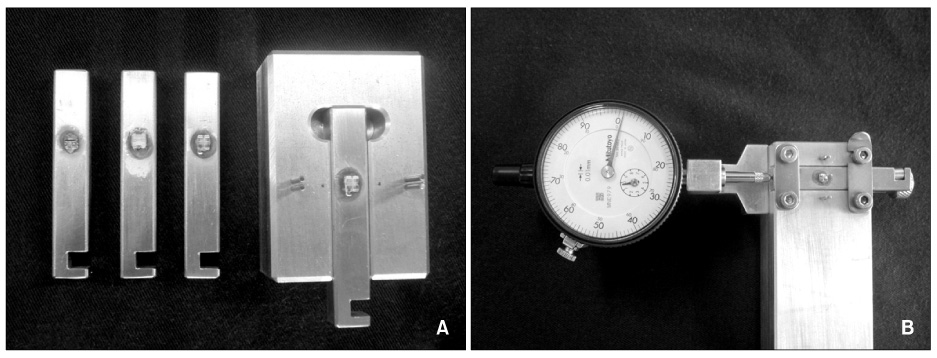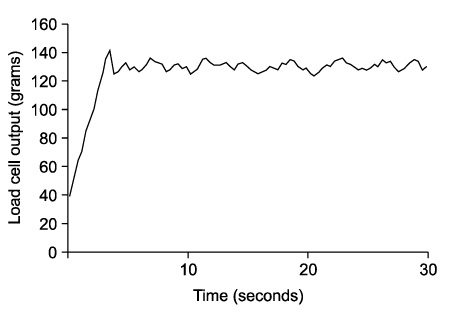Korean J Orthod.
2011 Dec;41(6):399-410. 10.4041/kjod.2011.41.6.399.
The comparison of the frictional force by the type and angle of orthodontic bracket and the coated or non-coated feature of archwire
- Affiliations
-
- 1Department of Orthodontics, School of Dentistry, Wonkwang University, Korea. pigtail@wonkwang.ac.kr
- KMID: 2273188
- DOI: http://doi.org/10.4041/kjod.2011.41.6.399
Abstract
OBJECTIVE
The purpose of this study was to evaluate the difference in frictional resistance among metal, ceramic, self-ligation brackets and coated or non-coated Ni-Ti archwires at various bracket-archwire angulations during the sliding movement of an orthodontic archwire, using an orthodontic sliding simulation device.
METHODS
Four types of bracket (Micro-arch Perpect Clear2 Clippy-C and Damon3 and 5 types of orthodontic archwire (0.014", 0.016", and 0.016" x 0.022" inch coated Ni-Ti, and 0.016" and 0.016" x 0.022" inch Ni-Ti) were used. Further, the bracket-archwire angles were set at 4 different angulations: 0degrees, 3degrees, 6degrees, and 9degrees.
RESULTS
The frictions from all the experimental groups were found to be significantly increased in order of self-ligation brackets, Micro-arch and Perpect Clear2 (p < 0.001). The presence of a coat had no effect on the friction of the same sized archwires at 0degrees and 3degrees bracket-archwire angles (p < 0.001). Coated archwires had significantly higher frictions than the same sized non-coated archwires at 6degrees and 9degrees bracket-archwire angles (p < 0.001). The frictions increased significantly as the bracket-archwire angles were increased (p < 0.001).
CONCLUSIONS
The use of self-ligation brackets will be beneficial in clinical situations where a low frictional force is required. Further, in cases where crowding is not severe, the use of coated archwires should not cause problems. However, more additional explanation is required considering the fact that the damage of coated archwire and exposure of the metal portion in case of binding and notching and the effects of saliva were not taken into account.
Keyword
Figure
Cited by 1 articles
-
Comparison of frictional forces between aesthetic orthodontic coated wires and self-ligation brackets
Yunmi Kim, Jung-Yul Cha, Chung-Ju Hwang, Hyung Seog Yu, Seon Gun Tahk
Korean J Orthod. 2014;44(4):157-167. doi: 10.4041/kjod.2014.44.4.157.
Reference
-
1. Seong BN. Basic physics. 1981. Seoul: Ewoo Publication;60–63.2. Cho MS, Kim JC. Frictional forces in the fixed orthodontic appliance during tooth movement. Korean J Orthod. 1990. 20:409–417.3. Graber TM, Vanarsdall RL, Vig KWL. Orthodontics: current orthodontic concepts and techniques. 2005. 4th ed. St Louis: Elsevier Mosby;303–304.4. Stoner MM. Force control in clinical practice. Am J Orthod. 1960. 46:163–168.
Article5. Drescher D, Bourauel C, Schumacher HA. Frictional forces between bracket and arch wire. Am J Orthod Dentofacial Orthop. 1989. 96:397–404.
Article6. Kusy RP, Whitley JQ. Friction between different wire-bracket configurations and materials. Semin Orthod. 1997. 3:166–177.7. Burrow SJ. Friction and resistance to sliding in orthodontics: a critical review. Am J Orthod Dentofacial Orthop. 2009. 135:442–447.
Article8. Redlich M, Mayer Y, Harari D, Lewinstein I. In vitro study of frictional forces during sliding mechanics of "reduced-friction" brackets. Am J Orthod Dentofacial Orthop. 2003. 124:69–73.
Article9. Nishio C, da Motta AF, Elias CN, Mucha JN. In vitro evaluation of frictional forces between archwires and ceramic brackets. Am J Orthod Dentofacial Orthop. 2004. 125:56–64.
Article10. Suh CW, Jung HS, Cho JH, Kang KH. Comparison of frictional forces between orthodontic brackets and archwires. Korean J Orthod. 2005. 35:116–126.11. Kusy RP, Whitley JQ. Influence of archwire and bracket dimensions on sliding mechanics: derivations and determinations of the critical contact angles for binding. Eur J Orthod. 1999. 21:199–208.
Article12. Kapur Wadhwa R, Kwon HK, Sciote JJ, Close JM. Frictional resistance in ceramic and metal brackets. J Clin Orthod. 2004. 38:35–38.13. Jeong TJ, Choie MK. Evaluation of frictional forces between orthodontic brackets and archwires. Korean J Orthod. 2000. 30:613–623.14. Krishnan M, Kalathil S, Abraham KM. Comparative evaluation of frictional forces in active and passive self-ligating brackets with various archwire alloys. Am J Orthod Dentofacial Orthop. 2009. 136:675–682.
Article15. Stefanos S, Secchi AG, Coby G, Tanna N, Mante FK. Friction between various self-ligating brackets and archwire couples during sliding mechanics. Am J Orthod Dentofacial Orthop. 2010. 138:463–467.
Article16. Cacciafesta V, Sfondrini MF, Ricciardi A, Scribante A, Klersy C, Auricchio F. Evaluation of friction of stainless steel and esthetic self-ligating brackets in various bracket-archwire combinations. Am J Orthod Dentofacial Orthop. 2003. 124:395–402.
Article17. Thorstenson GA, Kusy RP. Effect of archwire size and material on the resistance to sliding of self-ligating brackets with second-order angulation in the dry state. Am J Orthod Dentofacial Orthop. 2002. 122:295–305.
Article18. Michelberger DJ, Eadie RL, Faulkner MG, Glover KE, Prasad NG, Major PW. The friction and wear patterns of orthodontic brackets and archwires in the dry state. Am J Orthod Dentofacial Orthop. 2000. 118:662–674.
Article19. Han JS, Lee JW, Cha KS. A comparative study of frictional forces according to orthodontic wires and ligation method under dry and wet conditions. Korean J Orthod. 2001. 31:271–281.20. Kusy RP. Orthodontic biomaterials: from the past to the present. Angle Orthod. 2002. 72:501–512.21. Elayyan F, Silikas N, Bearn D. Mechanical properties of coated superelastic archwires in conventional and self-ligating orthodontic brackets. Am J Orthod Dentofacial Orthop. 2010. 137:213–217.
Article22. Choi WC, Kim TW, Park JY, Kwak JH, Na HJ, Park DN. The effect of bracket width on frictional force between bracket and arch wire during sliding tooth movement. Korean J Orthod. 2004. 34:253–260.23. Tanne K, Matsubara S, Shibaguchi T, Sakuda M. Wire friction from ceramic brackets during simulated canine retraction. Angle Orthod. 1991. 61:285–290.24. Bednar JR, Gruendeman GW, Sandrik JL. A comparative study of frictional forces between orthodontic brackets and arch wires. Am J Orthod Dentofacial Orthop. 1991. 100:513–522.
Article25. Shivapuja PK, Berger J. A comparative study of conventional ligation and self-ligation bracket systems. Am J Orthod Dentofacial Orthop. 1994. 106:472–480.
Article26. Lee JH, Lee KS. An experimental study of dynamic frictional resistance between orthodontic bracket and arch wire. Korean J Orthod. 2001. 31:467–477.27. Kapila S, Angolkar PV, Duncanson MG Jr, Nanda RS. Evaluation of friction between edgewise stainless steel brackets and orthodontic wires of four alloys. Am J Orthod Dentofacial Orthop. 1990. 98:117–126.
Article28. Cha JY, Kim KS, Kim DC, Hwang CJ. Evaluation of friction of ceramic brackets in various bracket-wire combinations. Korean J Orthod. 2006. 36:125–135.
- Full Text Links
- Actions
-
Cited
- CITED
-
- Close
- Share
- Similar articles
-
- Frictional forces in the fixed orthodontic appliance during tooth movement
- A study on frictional resistance force of orthodontic resin bracket
- Frictional forces between orthodontic wire and bracket under artificial saliva
- A comparative study of frictional force in self-ligating brackets according to the bracket-archwire angulation, bracket material, and wire type
- Comparison of frictional forces between orthodontic brackets and archwires




